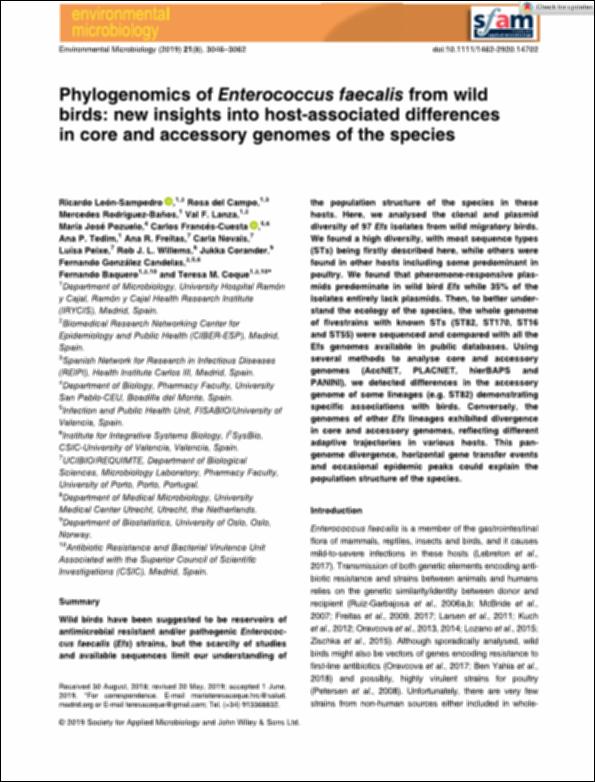Please use this identifier to cite or link to this item:
http://hdl.handle.net/10637/15024Phylogenomics of Enterococcus faecalis from wild birds: new insights into host-associated differences in core and accessory genomes of the species
| Title: | Phylogenomics of Enterococcus faecalis from wild birds: new insights into host-associated differences in core and accessory genomes of the species |
| Authors : | León-Sampedro, Ricardo Campo, Rosa del Rodriguez-Baños, Mercedes Lanza, Val F. Pozuelo de Felipe, María José Francés-Cuesta, Carlos Tedim, Ana P. Freitas, Ana R. Novais, Carla Peixe, Luísa Willems, Rob J. L. Corander, Jukka González Candelas, Fernando Baquero, Fernando Coque, Teresa M. |
| Keywords: | Environmental; Microbiology; Enterococcus faecalis; Wild birds |
| Publisher: | Wiley |
| Citation: | León-Sampedro R, Del Campo R, Rodriguez-Baños M, Lanza VF, Pozuelo MJ, Francés-Cuesta C, Tedim AP, Freitas AR, Novais C, Peixe L, Willems RJL, Corander J, González Candelas F, Baquero F, Coque TM. Phylogenomics of Enterococcus faecalis from wild birds: new insights into host-associated differences in core and accessory genomes of the species. Environ Microbiol. 2019 Aug;21(8):3046-3062. doi: 10.1111/1462-2920.14702. Epub 2019 Jul 4. PMID: 31162871. |
| Abstract: | Wild birds have been suggested to be reservoirs of antimicrobial resistant and/or pathogenic Enterococcus faecalis (Efs) strains, but the scarcity of studies and available sequences limit our understanding of the population structure of the species in these hosts. Here, we analysed the clonal and plasmid diversity of 97 Efs isolates from wild migratory birds. We found a high diversity, with most sequence types (STs) being firstly described here, while others were found in other hosts including some predominant in poultry. We found that pheromone-responsive plasmids predominate in wild bird Efs while 35% of the isolates entirely lack plasmids. Then, to better understand the ecology of the species, the whole genome of fivestrains with known STs (ST82, ST170, ST16 and ST55) were sequenced and compared with all the Efs genomes available in public databases. Using several methods to analyse core and accessory genomes (AccNET, PLACNET, hierBAPS and PANINI), we detected differences in the accessory genome of some lineages (e.g. ST82) demonstrating specific associations with birds. Conversely, the genomes of other Efs lineages exhibited divergence in core and accessory genomes, reflecting different adaptive trajectories in various hosts. This pangenome divergence, horizontal gene transfer events and occasional epidemic peaks could explain the population structure of the species. |
| URI: | http://hdl.handle.net/10637/15024 |
| Rights : | http://creativecommons.org/licenses/by-nc-nd/4.0/deed.es |
| ISSN: | 1462-2912 |
| Issue Date: | Aug-2019 |
| Center : | Universidad San Pablo-CEU |
| Appears in Collections: | Facultad de Farmacia |
Items in DSpace are protected by copyright, with all rights reserved, unless otherwise indicated.


